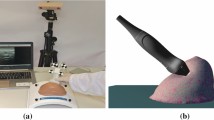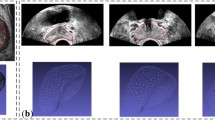Abstract
Purpose
Although ultrasound (US) images represent the most popular modality for guiding breast biopsy, malignant regions are often missed by sonography, thus preventing accurate lesion localization which is essential for a successful procedure. Biomechanical models can support the localization of suspicious areas identified on a preoperative image during US scanning since they are able to account for anatomical deformations resulting from US probe pressure. We propose a deformation model which relies on position-based dynamics (PBD) approach to predict the displacement of internal targets induced by probe interaction during US acquisition.
Methods
The PBD implementation available in NVIDIA FleX is exploited to create an anatomical model capable of deforming online. Simulation parameters are initialized on a calibration phantom under different levels of probe-induced deformations; then, they are fine-tuned by minimizing the localization error of a US–visible landmark of a realistic breast phantom. The updated model is used to estimate the displacement of other internal lesions due to probe-tissue interaction.
Results
The localization error obtained when applying the PBD model remains below 11 mm for all the tumors even for input displacements in the order of 30 mm. This proposed method obtains results aligned with FE models with faster computational performance, suitable for real-time applications. In addition, it outperforms rigid model used to track lesion position in US-guided breast biopsies, at least halving the localization error for all the displacement ranges considered.
Conclusion
Position-based dynamics approach has proved to be successful in modeling breast tissue deformations during US acquisition. Its stability, accuracy and real-time performance make such model suitable for tracking lesions displacement during US-guided breast biopsy.







Similar content being viewed by others
Change history
27 June 2019
The original version of this article unfortunately contained a mistake.
References
O’Flynn E, Wilson A, Michell M (2010) Image-guided breast biopsy: state-of-the-art. Clin Radiol 65(4):259–270
Apesteguía L, Pina LJ (2011) Ultrasound-guided core-needle biopsy of breast lesions. Insights Imaging 2(4):493–500
Guo R, Lu G, Qin B, Fei B (2017) Ultrasound imaging technologies for breast cancer detection and management: a review. Ultrasound Med Biol 44:37–70
Kucukkaya F, Aribal E, Tureli D, Altas H, Kaya H (2016) Use of a volume navigation technique for combining real-time ultrasound and contrast-enhanced MRI: accuracy and feasibility of a novel technique for locating breast lesions. Am J Roentgenol 206(1):217–225
Aribal E, Tureli D, Kucukkaya F, Kaya H (2017) Volume navigation technique for ultrasound-guided biopsy of breast lesions detected only at MRI. Am J Roentgenol 208(6):1400–1409
Hipwell JH, Vavourakis V, Han L, Mertzanidou T, Eiben B, Hawkes DJ (2016) A review of biomechanically informed breast image registration. Phys Med Biol 61(2):R1
Zhang J, Zhong Y, Gu C (2018) Deformable models for surgical simulation: a survey. IEEE Rev Biomed Eng 11:143–164
Bender J, Müller M, Macklin M (2017) A survey on position based dynamics, 2017. In: EUROGRAPHICS 2017 Tutorials
Bender J, Koschier D, Charrier P, Weber D (2014) Position-based simulation of continuous materials. Comput Graph 44:1–10
Rodero C, Real P, Zuñeda P, Monteagudo C, Lozano M, García-Fernández I (2016) Characterisation of position based dynamics for elastic materials. In: Proceedings of the XXVI spanish computer graphics conference, Eurographics Association, pp 49–57
Berndt I, Torchelsen R, Maciel A (2017) Efficient surgical cutting with position-based dynamics. IEEE Comput Graph Appl 38(3):24–31
Pan J, Bai J, Zhao X, Hao A, Qin H (2015) Real-time haptic manipulation and cutting of hybrid soft tissue models by extended position-based dynamics. Comput Animat Virtual Worlds 26(3–4):321–335
Wang Y, Xiong Y, Xu K, Tan K, Guo G (2006) A mass-spring model for surface mesh deformation based on shape matching. GRAPHITE 6:375–380
Xu L, Lu Y, Liu Q (2018) Integrating viscoelastic mass spring dampers into position-based dynamics to simulate soft tissue deformation in real time. R Soc Open Sci 5(2):171,587
Kubiak B, Pietroni N, Ganovelli F, Fratarcangeli M (2007) A robust method for real-time thread simulation. In: Proceedings of the 2007 ACM symposium on virtual reality software and technology, ACM, pp 85–88
Camara M, Mayer E, Darzi A, Pratt P (2017) Simulation of patient-specific deformable ultrasound imaging in real time. In: Cardoso MJ, Arbel T, Tavares JMRS, Aylward S, Li S, Boctor E, Fichtinger G, Cleary K, Freeman B, Kohli L, Shipley Kane D, Oetgen M, Pujol S (eds) Imaging for patient-customized simulations and systems for point-of-care ultrasound. Springer, Cham, pp 11–18. https://doi.org/10.1007/978-3-319-67552-7_2
Camara M, Mayer E, Darzi A, Pratt P (2016) Soft tissue deformation for surgical simulation: a position-based dynamics approach. Int J Comput Assist Radiol Surg 11(6):919–928
Müller M, Heidelberger B, Teschner M, Gross M (2005) Meshless deformations based on shape matching. ACM Trans Graph 24(3):471–478. https://doi.org/10.1145/1073204.1073216
(2018) NVIDIA gameworks. Nvidia FleX. https://developer.nvidia.com/flex. Accessed 20 Dec 2018
Lasso A, Heffter T, Rankin A, Pinter C, Ungi T, Fichtinger G (2014) Plus: open-source toolkit for ultrasound-guided intervention systems. IEEE Trans Biomed Eng 61(10):2527–2537
Fedorov A, Beichel R, Kalpathy-Cramer J, Finet J, Fillion-Robin JC, Pujol S, Bauer C, Jennings D, Fennessy F, Sonka M, Buatti J, Aylward S, Miller J, Pieper S, Kikinis R (2012) 3D slicer as an image computing platform for the quantitative imaging network. Magn Reson Imaging 30(9):1323–1341
Tokuda J, Fischer GS, Papademetris X, Yaniv Z, Ibanez L, Cheng P, Liu H, Blevins J, Arata J, Golby AJ, Kapur T, Pieper S, Burdette E, Fichtinger G, Tempany C, Hata N (2009) Openigtlink: an open network protocol for image-guided therapy environment. Int J Med Robot Comput Assist Surg 5(4):423–434
Amini R, Kartchner JZ, Stolz LA, Biffar D, Hamilton AJ, Adhikari S (2015) A novel and inexpensive ballistic gel phantom for ultrasound training. World J Emerg Med 6(3):225
Mitchell M (1998) An introduction to genetic algorithms. MIT Press, Cambridge
Yushkevich PA, Piven J, Cody Hazlett H, Gimpel Smith R, Ho S, Gee JC, Gerig G (2006) User-guided 3D active contour segmentation of anatomical structures: significantly improved efficiency and reliability. Neuroimage 31(3):1116–1128
Cignoni P, Callieri M, Corsini M, Dellepiane M, Ganovelli F, Ranzuglia G (2008) MeshLab: an open-source mesh processing tool. In: Scarano V, Chiara RD, Erra U (eds) Eurographics Italian chapter conference, The Eurographics Association
Audet C, Dennis JE Jr (2002) Analysis of generalized pattern searches. SIAM J Optim 13(3):889–903
Faure F, Duriez C, Delingette H, Allard J, Gilles B, Marchesseau S, Talbot H, Courtecuisse H, Bousquet G, Peterlik I, Cotin S (2012) SOFA: a multi-model framework for interactive physical simulation. In: Payan Y (ed) Soft tissue biomechanical modeling for computer assisted surgery. Studies in mechanobiology, tissue engineering and biomaterials, vol 11. Springer, Berlin, Heidelberg, pp 283–321. https://doi.org/10.1007/8415_2012_125
Visentin F, Groenhuis V, Maris B, DallAlba D, Siepel F, Stramigioli S, Fiorini P (2018) Iterative simulations to estimate the elastic properties from a series of MRI images followed by MRI-US validation. Med Biol Eng Comput 57:1–12
Schenk O, Gärtner K (2004) Solving unsymmetric sparse systems of linear equations with PARDISO. Future Gener Comput Syst 20(3):475–487
Moreira P, Peterlik I, Herink M, Duriez C, Cotin S, Misra S (2013) Modelling prostate deformation: sofa versus experiments. Prostate 17(83.0):1
Macklin M, Müller M, Chentanez N (2016) Xpbd: position-based simulation of compliant constrained dynamics. In: Proceedings of the 9th international conference on motion in games, ACM, pp 49–54
Acknowledgements
This Project has received funding from the European Research Council (ERC) under the European Union’s Horizon 2020 research and innovation programme (Grant Agreement Nos. 742671 “ARS” and 688188 “MURAB”).
Author information
Authors and Affiliations
Corresponding author
Ethics declarations
Conflict of interest
The authors declare that they have no conflict of interest.
Ethical approval
This article does not contain any studies with human participants or animals performed by any of the authors.
Additional information
Publisher's Note
Springer Nature remains neutral with regard to jurisdictional claims in published maps and institutional affiliations.
The original version of this article was revised: The presentation of Table 2 was incorrect.
Electronic supplementary material
Below is the link to the electronic supplementary material.
Supplementary material 1 (mp4 5085 KB)
Rights and permissions
About this article
Cite this article
Tagliabue, E., Dall’Alba, D., Magnabosco, E. et al. Position-based modeling of lesion displacement in ultrasound-guided breast biopsy. Int J CARS 14, 1329–1339 (2019). https://doi.org/10.1007/s11548-019-01997-z
Received:
Accepted:
Published:
Issue Date:
DOI: https://doi.org/10.1007/s11548-019-01997-z




